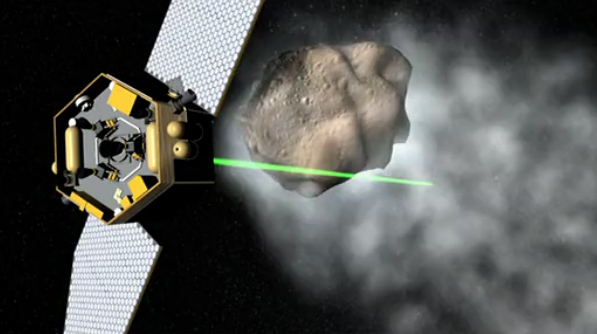NASA Studies 'Tractor Beams' for Stardust-Snatching Robot Probes

Tractor beams don't yet exist to snatch fleeing starships, but lasers in lab experiments have shown the ability to trap and move tiny particles. That has persuaded NASA to spend $100,000 to see whether lasers can be used on robotic space missions to capture stardust.
The investigation by a team at NASA Goddard Space Flight Center aims to examine three possible ways to control particles with laser beams. Such technology would allow robotic rovers and orbiters to collect samples from Mars' atmosphere, for instance, or give deep-space probes a longer reach for scooping up passing particles.
"Though a mainstay in science fiction, and 'Star Trek' in particular, laser-based trapping isn't fanciful or beyond current technological know-how," said Paul Stysley, a laser engineer at the NASA Goddard Space Flight Center in Greenbelt, Md.
NASA originally considered the idea of tractor beams to solve the problem of space junk that has created a cloud of orbital debris around Earth.
"But to pull something that huge would be almost impossible — at least now," Stysley explained. "That's when it bubbled up that perhaps we could use the same approach for sample collection." [Top 10 Star Trek Technologies Today]
One way to collect samples in a planetary atmosphere involves the "optical tweezers" method. Two laser beams that overlap while going in opposite directions could create a ring-like shape that traps particles. Strengthening or weakening the intensity of either laser beam could heat the air around the trapped particle and move it along the ring's center.
For the vacuum of space, a different experimental tactic uses optical solenoid beams capable of trapping particles and pulling them back along the entire length of the light beam.
Get the Space.com Newsletter
Breaking space news, the latest updates on rocket launches, skywatching events and more!
The third technique has yet to undergo a lab experiment. It involves a "Bessel beam" that creates rings of light around a central dot when it is shined against a wall. Theory suggests that such a scattering of laser light could create electric and magnetic fields in the path of a particle that pull the object backward against the beam's own movement.
If all goes well, lasers could someday replace current sample-collection techniques in space. NASA's Stardust mission used aerogel – a lightweight, porous material also known as frozen smoke – to trap samples as the probe flew through the outer atmosphere of comet Wild 2. Robotic rovers and landers have used scoops and arms to scrape samples from the surface of Mars.
"An optical trapping system, on the other hand, could grab desired molecules from the upper atmosphere on an orbiting spacecraft or trap them from the ground or lower atmosphere from a lander," Stysley said. "In other words, they could continuously and remotely capture particles over a longer period of time, which would enhance science goals and reduce mission risk."
You can follow InnovationNewsDaily Senior Writer Jeremy Hsu on Twitter @ScienceHsu. Follow InnovationNewsDaily on Twitter @News_Innovation, or on Facebook.
Join our Space Forums to keep talking space on the latest missions, night sky and more! And if you have a news tip, correction or comment, let us know at: community@space.com.
Jeremy Hsu is science writer based in New York City whose work has appeared in Scientific American, Discovery Magazine, Backchannel, Wired.com and IEEE Spectrum, among others. He joined the Space.com and Live Science teams in 2010 as a Senior Writer and is currently the Editor-in-Chief of Indicate Media. Jeremy studied history and sociology of science at the University of Pennsylvania, and earned a master's degree in journalism from the NYU Science, Health and Environmental Reporting Program. You can find Jeremy's latest project on Twitter.










